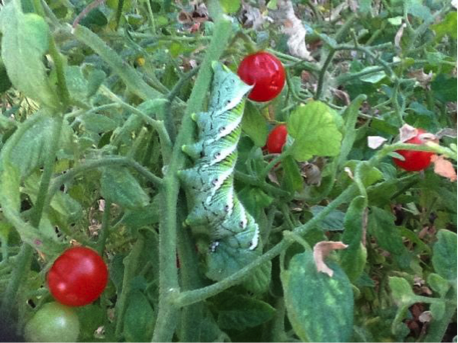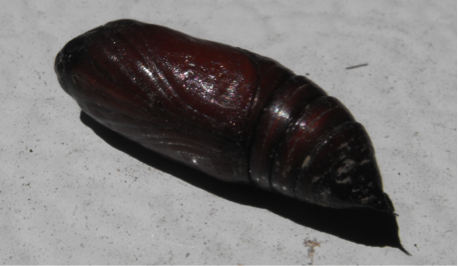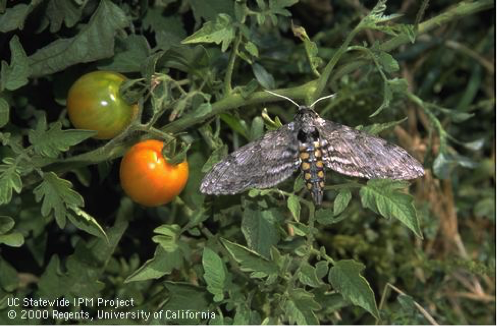Large Green Caterpillar Feeding on my Tomato Leaves
Question:
I saw a large green caterpillar feeding on my green tomato leaves. Could it also be chewing on the fruit?

Tomato Hornworm
Answer:
Yes, the caterpillar on your plant is probably the tomato hornworm. It is a common pest in gardens.

Pupa
Tomato hornworms are well camouflaged among the leaves of their host plants. The body is green with a blackish horn protruding from the end, and a series of white V-shaped markings along the sides of the body. Tomato hornworms are likely to be the largest caterpillars you will see in the vegetable garden. Mature larvae can grow up to four inches long but their striping pattern makes them hard to spot despite their size. Black or green droppings (fecal pellets) on leaves are clue that hornworms are present. Larvae feed for 3 or 4 weeks, then burrow into the soil to pupate and transform into the adult moth.
 Adults of the tomato hornworm are known as five-spotted hawkmoths, due to the pairs of orange-yellow markings along the sides of the abdomen. The adult moth is a strong flier with a wingspan up to 5 inches (12 cm). Development, from egg to adult, takes about 2 months in summer. During winter the larvae remains in the pupal stage. The adult moth is active at night, feeding on nectar from flowers and laying solitary eggs on tomato plants.
Adults of the tomato hornworm are known as five-spotted hawkmoths, due to the pairs of orange-yellow markings along the sides of the abdomen. The adult moth is a strong flier with a wingspan up to 5 inches (12 cm). Development, from egg to adult, takes about 2 months in summer. During winter the larvae remains in the pupal stage. The adult moth is active at night, feeding on nectar from flowers and laying solitary eggs on tomato plants.
Hornworms feed on leaves, tender stems, blossoms, and fruit. Small parasitic wasps and other natural enemies may effectively control hornworms but using broad spectrum insecticides can disrupt biological control. At high populations, hornworms can extensively defoliate plants and scar the fruit. Entire leaves and small stems may be consumed. Large pieces from green fruit may also be chewed. Two other caterpillars, the tomato fruit worm (also known as the corn ear worm) and the pin worm also feed on green tomatoes, but these larvae tunnel into the fruit.
Tomato hornworms are easy to control in a home garden. Periodically monitor your tomato plants to look for the larvae and signs of their presence such as droppings on leaves, defoliation, or fruit damage. Removing caterpillars by hand can be an effective means of control. Insecticides are available if hand picking is not practical. Bacillus thuringiensis (Bt), a biological insecticide, is a widely available organic option for control of hornworms. The insecticide kills only caterpillars and will not harm other insects, birds or animals. Caterpillars must ingest the Bt for it to be effective. More than one application may be required to control an infestation since sunlight inactivates Bt in a day or two. Bt may also be washed off of the plants by rain or irrigation water. Always follow label instructions and monitor plants for damage after application of any insecticide.

